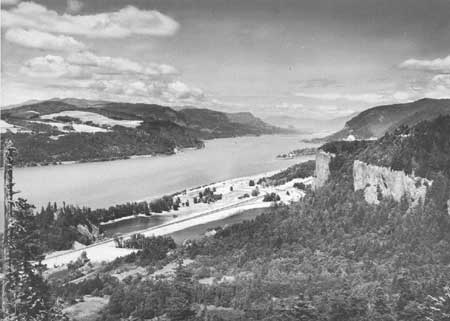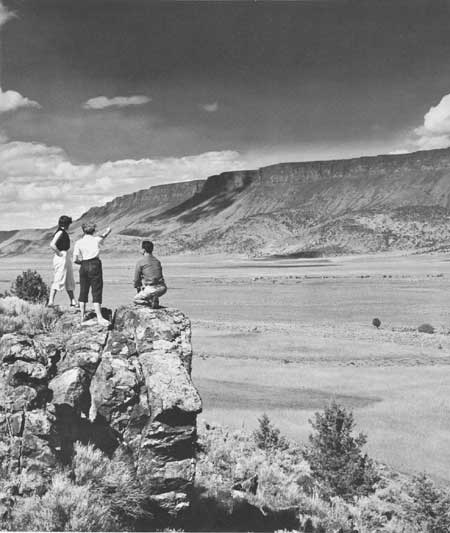.gif)
Parks for America
MENU
|
Parks for America
|

|
THE WEST
The western region of the United States* contains a wide variety of physiographic features that include major mountain masses, great rivers, interior basins, and the Pacific coast shoreline. It is a land of sharp contrast: highest and lowest points in the co-terminous United States; the driest and wettest regions—bare desert and the Olympic rain forest. Some sections are densely populated, while others are the most sparsely settled in the Nation. Open space is a predominant characteristic.
* As defined by the Bureau of the census and used by the Outdoor Recreation Resources Review Commission, the western region also includes Alaska and Hawaii. Individual state summaries, maps, and tabulations have been prepared for these 2 States, but only the 11 contiguous western States are considered as a planning unit in this regional summary statement.
Bounded physically by the Rocky Mountains and the Pacific Ocean and politically by Canada and Mexico, the western region presents park and recreation area planning problems of interstate, national, and international scope. In the summer the scenic, cool Pacific coast from San Diego to Seattle offers respite to the residents of the arid, inland States. In the winter, the warm desert climate of southern California, Nevada, Arizona, and New Mexico attracts visitors from all over the Nation. Then, too, there is a north-south seasonal migration of retired or semiretired trailerites who enjoy the cool summers in the forested, mountainous regions and then move south to spend their winters basking in the warm, winter sunshine of the desert States.
The cool summer climate of the Rocky Mountain States draws outdoor recreationists from both east and west of the Continental Divide. In the winter these same areas, as well as the mountainous sections of the other Western States, become a mecca for winter sports enthusiasts from all over the country. As a result, comprehensive park and recreation area planning cannot be confined by individual State boundaries and intrastate population considerations.

|
| Even in the spacious West, outstanding scenic features need protection and careful planning for recreation use. A State parkway is recommended for the Columbia River Gorge, seen here from a point east of Portland overlooking the present U.S. 30 Scenic Route. (OREGON STATE HIGHWAY DEPARTMENT.) |
The people of the West are concentrated along the Pacific coast in the Seattle, Portland, San Francisco-Oakland, and Los Angeles-Long Beach-San Diego metropolitan centers and in the interior metropolitan centers of Denver, Salt Lake City, Phoenix, and Albuquerque. As a whole, the West is the least settled region in the United States. It is, however, the fastest growing region in the Nation, and its metropolitan areas will receive the major portion of this increase.
The economy of the West is as diverse as its climate and physiography. It has major agriculture, manufacturing, lumber, mining, ranching, and recreation industries. Outdoor recreation and tourism are important segments of its economy, and in some sections are the main industry.
The metropolitan populace of the West pours out in ever-increasing numbers into the extensive mountain, desert, forest, and ocean recreation regions. The western recreationist travels greater distances to outdoor recreation grounds than does his eastern counterpart because of necessity, facility, and a pioneer attitude that puts flexibility and adventure in recreation pursuits. The millions of inhabitants in the Los Angeles and San Francisco areas range afar into the Pacific Northwest, the Rocky Mountains, and the Grand Canyon country seeking recreation pursuits. The West has the greatest amount of public outdoor recreation acreage in the country, for the bulk of the national parks and forests are located there. Great use pressures are placed on them by residents of the region and by eastern recreationists flocking to the West to enjoy the open, wild country and the unique, spectacular scenery. The numerous irrigation, power, and flood-control reservoirs receive extensive boating use, some of them on a year-round basis.
Private enterprise plays an important role in outdoor recreation and tourism through resorts and through commercial development operations connected with the national parks, national forests, and water reservoirs. Major resorts at Phoenix, Palm Springs, Sun Valley, Colorado Springs, Estes Park, and Aspen at tract vacationists from all over the country. Dude ranches are scattered throughout the mountain and desert regions. Indian reservations also offer many recreation opportunities and tourist attractions.

|
| Many scenic features in the West have scientific importance. An example is the Abert Rim, a long earthquake fault in Oregon, suggested as a State scientific monument. (OREGON STATE HIGHWAY DEPARTMENT.) |
The West has varied and abundant resources sufficient to meet present and future needs. The high percentage of Federal and State ownership of existing and potential nonurban outdoor recreation lands, if properly utilized, can contribute importantly to well-balanced systems of park, recreation, historic, and related areas. There are, however, specific needs that require immediate attention. The expanding western metropolitan centers need close-in park and recreation areas. Public acquisition of the few remaining Pacific coast shoreline opportunities is required before urbanization and other encroachments remove them from the outdoor recreation picture. Sufficient public lands adjacent to reservoirs should be acquired to assure public access and use. Additions should be made to National Park and State Park Systems to round them out and protect all significant park resources. Historic and archeological site protection and interpretation is weak in some States and should be strengthened.
The opportunity now exists in the West to achieve these goals with a minimum degree of difficulty and expense. Each year will see expanding population, urbanization, and commercial development increasing the difficulties and expense of meeting outdoor recreation needs. Action to meet these needs, though, must be done on a regionwide rather than a State-by-State basis. The individual State plans that follow have taken the regionwide needs into consideration.
NEXT >>>
|
|
Last Modified: Mon, Sep 6 2004 10:00:00 pm PDT
parks_america/west.htm
 Top
Top